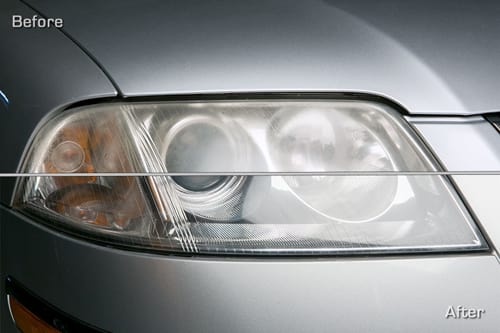
Cars get old and if you're part of the vast majority of Americans who own a set of wheels at least 11 years old, we're pretty sure those front headlights could use a makeover. Clean headlights not only make your vehicle look like new, but they allow for safe and unobstructed travel by clearly illuminating the road ahead.
Haze, fog, smear, whatever you want to call it, there are easy ways to get rid of that plastic oxidation that fogs up your vehicle's headlights after years and miles of driving.
There are numerous headlight restoration kits available for sale at auto parts and home improvement stores. For this story, we tested two different kits: a $25 kit from Mequiar's and one that cost $10 from Turtle Wax. Both kits come with a cleaning-clarifying compound, wet sanding pads and a protectant sealer solution. What do you get for $15 more? The more-advanced Meguiar's kit provides a clean microfiber detailing cloth, an ergonomic hand grip for the wet sanding pads and a polishing buffing ball that mounts to a drill. The cheaper Turtle Wax kit came with two solutions and a numbered set of sanding pads.
What you need:
- Headlight restoration kit
- Car wash solution, window cleaner or a spray bottle with cold water
- Masking or painters tape
- Power drill (optional depending on the restoration kit)
- Dry towels or detailing cloths
- Elbow grease and patience
Steps:
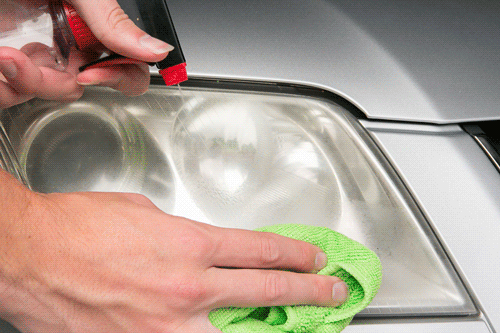
1. Clean the headlight area with soap and water to remove surface-level dirt and debris. Windex or a household glass cleaner can also do the trick. Make sure the headlights are completely dry, and then move to Step 2.
2. Once dry, tape off the surrounding areas near the headlights (any of the car's painted body panels that touch the headlights). This is an important precaution as it prevents sanding damage to your car's paint during the restoration process.
Some headlight restoration kits, like the Turtle Wax one we used, will require you to apply a coat of clarifying compound to the headlamp assembly before any wet sanding is done.
Other headlight restoration kits may skip the sanding needed in Steps 3-5 and instruct you to just begin polishing.

3. Both headlight restoration kits provided a few different grits or strengths of sandpaper to use. Using a spray bottle filled with water or a provided lubrication liquid, dose the headlight and get the lowest number piece of sandpaper wet.
4. In a side-to-side motion, rub with pressure the lowest number (1,000 or 1) sandpaper piece across the headlight's surface, being careful not to touch any other part of the car's body. You want to create a full "glazed" look that covers the headlight assembly. Always keep the sandpaper piece and the headlight assembly wet with water.
5. Move on to the next highest number (2,000 or 2) grit of sandpaper, and rub across the headlight in an opposite up-and-down motion. Continue, unless instructed otherwise, to keep the sandpaper and headlight assembly wet.
The Turtle Wax kit (shown above) came with two more levels of sandpaper at finer grits, leading to more sanding. These small pads required more effort to use but were also able to tackle the curved areas of the headlights better than the Meguiar's kit (shown below).

Steps 3-5 can take anywhere from 10-30 minutes depending on how cloudy the headlights are. Be patient and be careful not to accidentally touch the applicator to any other part of your car. Scratches and paint damage may occur.
6. Dry the headlight lens assembly with a paper towel or detailing cloth.

7. Apply a dab of the provided polisher liquid or paste to an applicator pad or buffing ball (like the one included in the Meguiar's kit shown above). Using the applicator pad or buffing ball, pan continuously back and forth over the headlight to clear up the wet-sanded glaze. You should be able to see a difference in the clarity of your vehicle's headlight(s) almost immediately. Again, the buffing ball didn't tackle the curved surfaces of the headlights as well as the Turtle Wax kit.
8. Dry the headlight lens assembly with a paper towel or detailing cloth.

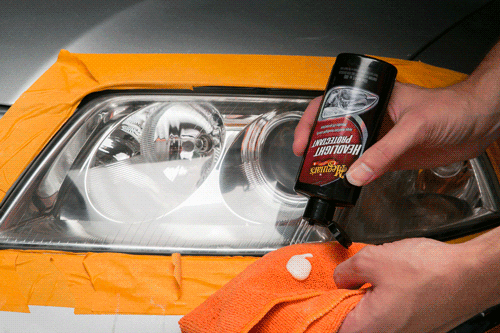
9. Once you are satisfied with the improved look of your headlights, finish the job by pouring a conservative amount of sealer protectant onto a separate applicator pad or towel — or in the case of the Turtle Wax kit (top image above), a small towelette with the protectant already applied — and rub it over the headlights.
10. Remove the tape around the headlights and you're done. Make sure to let the sealant sit for a few hours, if possible, to allow everything to dry and seal, ensuring a new, protective cover.
This process isn't just for headlamps. You can repeat the process on vehicle taillights, side markers or plastic fog lamps. Do not use these products on glass.
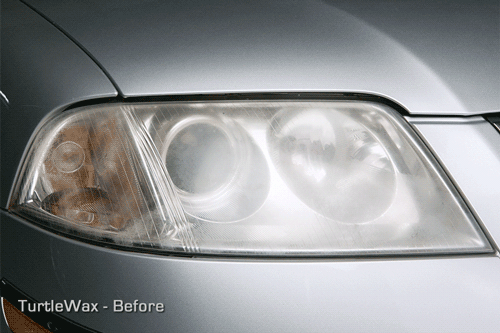
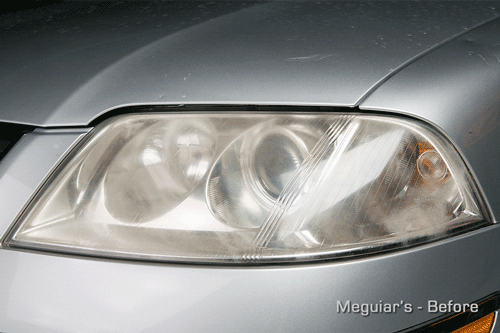
While both kits provided noticeable improvement in headlight clarity, the cheaper Turtle Wax kit did a superior job eliminating haze and discoloration from the entire lens, despite there being more laborious steps throughout the wet sanding and polishing processes. Even though the more-advanced Meguiar's kit was quicker and more ergonomically pleasing, Turtle Wax's basic $10 kit was our shining winner thanks to some good-old elbow grease.
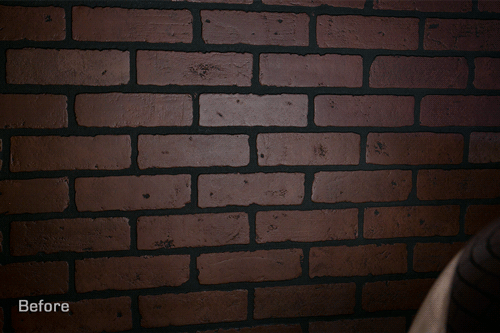
The cost savings of doing this type of work yourself is also significant. Independent body shops will charge around $60 to restore your vehicle's headlights, while one Chicago area Volkswagen dealership quoted us $100 to do the work.
*While we hope to help, Cars.com is not responsible for any damage that may occur to your vehicle by following the steps above.
Cars.com purchased both headlight kits independently and there was no contact with representatives from either company.
Related
More How Tos
More Car Maintenance Stories
How to Get Your Car Ready to Sell








